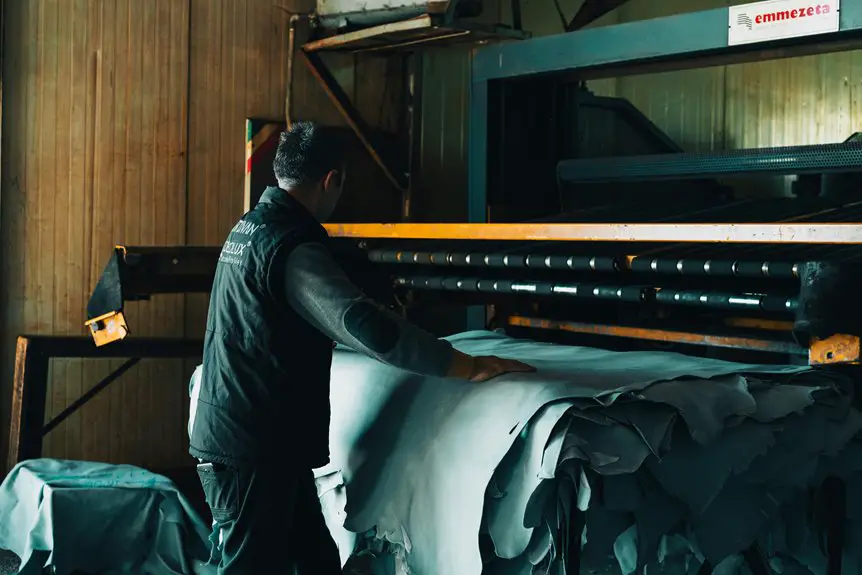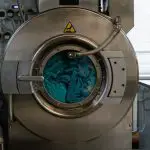When considering the age-old debate of nature versus industrial advancement, the choice between vegetable-tanned and chrome-tanned leather stands out. While both options offer unique qualities, their environmental footprints differ markedly. You might wonder, which method truly aligns with sustainable practices? By examining the tanning processes and their impacts, you can uncover the greener path for your leather needs.
Table of Contents
Key Takeaways
- Vegetable tanning uses natural plant extracts, making it more eco-friendly compared to chrome tanning’s reliance on toxic chemicals.
- Chrome tanning often leads to environmental pollution due to heavy metal waste, while vegetable tanning is biodegradable.
- Long-term exposure to chrome chemicals poses health risks, whereas vegetable tanning reduces chemical exposure and health concerns.
- The demand for sustainable leather options is rising, encouraging companies to adopt eco-friendly practices like vegetable tanning.
- Although initially costlier, vegetable-tanned leather production offers long-term environmental benefits and aligns with consumer preferences for sustainability.
Understanding the Tanning Processes
When you immerse yourself in the world of leather, understanding the tanning processes is essential. Tanning transforms raw animal hides into durable leather, making it suitable for various uses.
There are primarily two methods: vegetable tanning and chrome tanning. Vegetable tanning uses natural plant extracts, resulting in a more environmentally friendly product. This process can take several weeks, allowing the leather to develop a rich patina over time.
Vegetable tanning, utilizing natural plant extracts, creates eco-friendly leather that matures beautifully over several weeks.
On the other hand, chrome tanning is quicker, typically lasting only a day. It employs chemical agents to produce a flexible leather that resists water and mold.
Each method has its distinct characteristics, influencing the leather’s texture, durability, and appearance, so knowing these processes helps you make informed decisions when choosing leather products.
Environmental Impact of Tanning Methods
The choice between vegetable-tanned and chrome-tanned leather isn’t just about aesthetics or texture; it also has significant environmental implications. Vegetable tanning uses natural materials, which typically results in a more eco-friendly process. On the other hand, chrome tanning can involve toxic chemicals that pose risks to ecosystems and human health.
Here’s a quick comparison:
| Tanning Method | Environmental Impact | Chemical Usage |
|---|---|---|
| Vegetable-Tanned | Lower impact, biodegradable | Natural tannins |
| Chrome-Tanned | Higher impact, potential pollution | Heavy metals, toxins |
Comparing Leather Durability and Sustainability
While both vegetable-tanned and chrome-tanned leather offer unique characteristics, their durability and sustainability can vary considerably.
Vegetable-tanned leather, made from natural plant extracts, is generally more robust and ages beautifully over time, making it a great choice for long-lasting products. It’s also biodegradable, contributing positively to sustainability.
In contrast, chrome-tanned leather is often more resistant to water and stains, which can be advantageous for specific applications, but it typically has a shorter lifespan and is less environmentally friendly due to the chemicals used in its tanning process.
Ultimately, if you prioritize durability and eco-friendliness, vegetable-tanned leather could be the better option for you, while chrome-tanned leather might suit your needs for specific, short-term uses.
Market Trends in Leather Tanning
As you explore the leather tanning market, you’ll notice significant growth patterns shaping the industry.
Sustainability is becoming a top priority for consumers, driving a shift in preferences toward eco-friendly options.
Staying informed about these trends will help you make better choices in your leather purchases.
Industry Growth Patterns
Despite the challenges posed by environmental regulations and consumer preferences, the leather tanning industry has shown remarkable resilience and adaptability. You’ll notice a shift towards more sustainable practices, with a growing demand for vegetable-tanned leather. As consumers become more eco-conscious, tanners are adjusting their methods to meet this demand.
Here’s a quick overview of current trends:
| Growth Drivers | Impact on the Industry |
|---|---|
| Eco-friendly materials | Increased production of vegetable-tanned leather |
| Technological advancements | Improved efficiency in tanning processes |
| Consumer awareness | Higher demand for sustainable options |
Sustainability in Demand
The growing trend towards sustainability is reshaping market dynamics in the leather tanning industry. As consumers become more environmentally conscious, you’re likely noticing a shift toward leather products that prioritize eco-friendly practices.
Companies are increasingly investing in vegetable tanning methods, which use natural materials and processes, reducing harmful chemicals. This shift not only appeals to your values but also positions brands as leaders in sustainable fashion.
Moreover, the demand for transparency in sourcing and production practices is on the rise. More than ever, you want to know where your products come from and how they’re made.
This push for sustainability is driving innovation, encouraging tanneries to adopt greener technologies and practices, ultimately shaping a more responsible leather market for everyone.
Consumer Preferences Shift
With a growing awareness of environmental issues, consumer preferences in the leather industry are shifting dramatically. More people are leaning towards vegetable-tanned leather due to its sustainable attributes. This shift reflects a broader trend where consumers prioritize eco-friendly products.
Here’s a quick comparison of consumer preferences:
| Leather Type | Popularity |
|---|---|
| Vegetable-Tanned Leather | Increasing |
| Chrome-Tanned Leather | Declining |
| Synthetic Alternatives | Steady |
| Upcycled Leather | Emerging |
As you can see, the demand for environmentally conscious options is on the rise. By choosing vegetable-tanned leather, you’re not just buying a product; you’re supporting sustainable practices and contributing to a greener future.
Aesthetic Qualities of Vegetable-Tanned vs. Chrome-Tanned Leather
While both vegetable-tanned and chrome-tanned leather have distinct aesthetic qualities, their differences can greatly influence your choice for specific projects.
Vegetable-tanned leather boasts a natural, rustic look, often developing a rich patina over time. This makes it ideal for items where character and aging play a significant role, like handmade goods and traditional crafts.
On the other hand, chrome-tanned leather offers a vibrant color palette and a smooth finish, making it perfect for modern styles and fashion accessories. Its uniform appearance can create a sleek, polished look that appeals to many.
Ultimately, your choice will depend on the desired aesthetic and how you envision the final product fitting into your design.
Applications and Use Cases for Each Type of Leather
When it comes to choosing leather for specific projects, understanding the applications and use cases for each type can guide your decision.
Vegetable-tanned leather is ideal for goods requiring durability and a natural finish, like belts, wallets, and high-quality bags. Its ability to develop a rich patina over time makes it popular among artisans and custom leatherworkers.
On the other hand, chrome-tanned leather is more suited for items needing flexibility and water resistance, such as shoes, garments, and upholstery. It’s often favored in mass production due to its quicker tanning process.
The Future of Sustainable Leather Production
As consumers increasingly prioritize sustainability, the leather industry is adapting to meet these demands by exploring eco-friendly tanning methods and sourcing practices.
You’ll see brands implementing vegetable tanning processes, which rely on natural materials, reducing chemical waste. Innovations like lab-grown leather or mushroom-based alternatives are gaining traction, offering cruelty-free options that appeal to eco-conscious shoppers.
Additionally, transparency in sourcing will become a key factor in your buying decisions, as brands showcase their commitment to ethical practices.
With advancements in technology, recycling leather and upcycling waste materials will also play a significant role in minimizing environmental impact.
As a consumer, your choices will drive the market toward a more sustainable future, encouraging companies to prioritize eco-friendly practices.
Frequently Asked Questions
How Does Vegetable Tanning Affect the Leather’s Smell Over Time?
Vegetable tanning gives leather a distinct, earthy smell that can improve over time. You’ll notice it mellowing as it ages, developing a richer aroma that many find appealing, making it a unique and enjoyable experience.
Are There Any Health Risks Associated With Chrome Tanning?
Picture a chrome-tanned leather factory, with workers wearing gas masks, dodging toxic fumes. Yes, there’re health risks. You might face skin irritation or respiratory issues. It’s not exactly a spa day, is it?
Can Vegetable-Tanned Leather Be Waterproofed Effectively?
Yes, you can effectively waterproof vegetable-tanned leather. By applying specialized waterproofing agents or waxes, you’ll create a barrier against moisture while preserving its natural look and breathability. Just remember to reapply as needed for best results.
What Are the Costs Involved in Vegetable Tanning vs. Chrome Tanning?
Tanning leather’s like choosing between two paths in a forest. Vegetable tanning often costs more due to time and natural materials, while chrome tanning is quicker and cheaper, but may involve less environmentally friendly processes.
How Do Consumers Perceive the Longevity of Each Leather Type?
You’ll find many consumers believe vegetable-tanned leather lasts longer due to its natural processes, while some prefer chrome-tanned for its durability and resistance to wear. Each type has its loyal supporters based on personal experience.
- Tetron Fabric for Marine Applications: Durability and Use Cases - June 18, 2025
- Tetron Fabric for Outdoor Furniture: Weather Resistance and Care - June 18, 2025
- Tetron Fabric for Wall Coverings: Style and Application Tips - June 18, 2025







